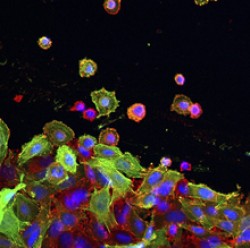Colon and Rectal Cancers Surprisingly Similar
Colon and Rectal Cancers Surprisingly Similar
Researchers discovered that the major difference between most colon and rectal cancers is where they start. These and other insights from a new study may change the way we identify and treat these cancers.

Cultured colon cancer cells. Image by Lorna McInroy, Wellcome Images. All rights reserved by Wellcome Images.
More than 143,000 people in the United States will be diagnosed with colorectal cancer this year, and more than 50,000 are likely to die of it. It’s the fourth most common cancer in men, after skin, prostate and lung cancer. It’s also the fourth most common cancer in women, after skin, breast and lung cancer.
The colon is the first several feet of the large intestine. The rectum is the last few inches. But cancers of the colon and rectum have practical differences beyond the anatomical. For example, patients with either cancer sometimes need different treatments. To get a better understanding of these cancers, scientists in The Cancer Genome Atlas Research Network performed a comprehensive genomic analysis of 224 colorectal cancer specimens and matched normal samples. The network, funded by NIH’s National Cancer Institute (NCI) and National Human Genome Research Institute (NHGRI), has done similar analyses of glioblastoma and ovarian cancer.
Network scientists initially considered colon tumors to be distinct from rectal tumors. As reported in the July 19, 2012, issue of Nature, however, the new study found that most colon and rectal tumors were nearly indistinguishable in multiple types of genomic analysis.
The one exception was when tumors were hypermutated—a state in which normal DNA repair mechanisms are disrupted, leading to a high rate of mutation. Colorectal cancers with hypermutation are often less aggressive. The scientists found that 16% of the specimens were hypermutated. Most of the hypermutated samples came from the right-hand side of the colon. Tumors from the right colon had other genetic differences as well. The reasons for these differences are unclear, but they may eventually help researchers make more accurate prognoses and design better treatments.
Aside from the hypermutated cancers, the colon and rectum tumors were so similar that the scientists grouped them together for most of their analyses. They found 24 genes that were significantly mutated. Several were already known to be involved in colorectal cancer, but the scientists also identified genes that hadn’t been linked to the disease before. Researchers will now study those genes as possible targets for drugs.
The investigators gained significant insights into cell signaling pathways as well. Among other findings, they discovered new mutations in a signaling cascade called the WNT pathway. They also identified RTK/RAS and PI3K as pathways that are altered in many colorectal tumors. Several proteins in these pathways could prove to be useful targets for therapies.
“While it may take years to translate this foundational genetic data on colorectal cancers into new therapeutic strategies and surveillance methods, this genetic information unquestionably will be the springboard for determining what will be useful clinically against colorectal cancers,” says NCI Director Dr. Harold E. Varmus.
###
* The above story is reprinted from materials provided by National Institutes of Health (NIH)
** The National Institutes of Health (NIH) , a part of the U.S. Department of Health and Human Services, is the nation’s medical research agency—making important discoveries that improve health and save lives. The National Institutes of Health is made up of 27 different components called Institutes and Centers. Each has its own specific research agenda. All but three of these components receive their funding directly from Congress, and administrate their own budgets.




















